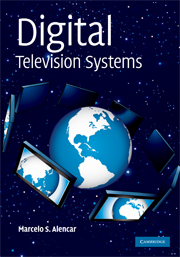Book contents
- Frontmatter
- Contents
- List of figures
- List of tables
- List of contributors
- Preface
- Acknowledgments
- 1 Fundamentals of digital television
- 2 Audio and video coding
- 3 Fundamentals and standards of video and audio compression
- 4 Channel coding for digital television
- 5 Digital and analog transmission systems
- 6 Advanced Television Systems Committee standard (ATSC)
- 7 Digital video broadcasting (DVB)
- 8 International Services Digital Broadcasting for Terrestrial Television Broadcasting (ISDB)
- 9 International System for Digital Television (ISDTV)
- 10 Digital terrestrial television multimedia broadcasting (DTMB)
- Appendix A Evolution of television standards
- Appendix B Signal analysis
- Appendix C Random signals and noise
- Glossary
- References
- Index
6 - Advanced Television Systems Committee standard (ATSC)
Published online by Cambridge University Press: 28 January 2010
- Frontmatter
- Contents
- List of figures
- List of tables
- List of contributors
- Preface
- Acknowledgments
- 1 Fundamentals of digital television
- 2 Audio and video coding
- 3 Fundamentals and standards of video and audio compression
- 4 Channel coding for digital television
- 5 Digital and analog transmission systems
- 6 Advanced Television Systems Committee standard (ATSC)
- 7 Digital video broadcasting (DVB)
- 8 International Services Digital Broadcasting for Terrestrial Television Broadcasting (ISDB)
- 9 International System for Digital Television (ISDTV)
- 10 Digital terrestrial television multimedia broadcasting (DTMB)
- Appendix A Evolution of television standards
- Appendix B Signal analysis
- Appendix C Random signals and noise
- Glossary
- References
- Index
Summary
Introduction
The Advanced Television Systems Committee, Inc. (ATSC) was formed in 1982 by the member organizations of the Joint Committee on InterSociety Coordination (JCIC): the Electronic Industries Alliance (EIA), the Institute of Electrical and Electronic Engineers (IEEE), the National Association of Broadcasters (NAB), the National Cable Television Association (NCTA), and the Society of Motion Picture and Television Engineers (SMPTE). Currently, there are approximately 140 members representing the broadcast, broadcast equipment, motion picture, consumer electronics, computer, cable, satellite, and semiconductor industries. ATSC digital television standards include digital high-definition television (HDTV), standard-definition television (SDTV), data broadcasting, multichannel surround-sound audio, and satellite direct-to-home broadcasting (ATSC, 2008).
In 1987, the Federal Communications Commission (FCC) formed a group of television industry entrepreneurs, the Advisory Committee on Advanced Television Service, to help it with the development of new technologies for television, as well as with the planning of public policy for organizing the exploration of possible applications of the research.
At first, 23 different systems were proposed to the Advisory Committee. These systems ranged from improved systems, which worked within the parameters of the NTSC system, to enhanced systems, which added additional information to the signal, and to HDTV systems, which presented substantially higher resolution, a wider picture aspect ratio, and improved sound.
The Advanced Television Test Center, funded by the broadcasting and consumer electronics industries, conducted transmission performance testing and subjective tests using expert viewers. Cable Television Laboratories, a research and development consortium of cable television system operators, conducted an extensive series of cable transmission tests as well. The Advanced Television Evaluation Laboratory within the Canadian Communications Research Centre conducted assessment tests using non-expert viewers.
- Type
- Chapter
- Information
- Digital Television Systems , pp. 118 - 136Publisher: Cambridge University PressPrint publication year: 2009



